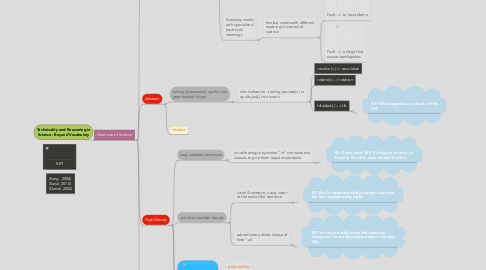
1. KEY
2. (Fang , 2008) (Sunal, 2010) (Daniel, 2002)
3. Grammar of Science
3.1. Technical Vocabulary
3.1.1. Two Types
3.1.1.1. Terms unique to science
3.1.1.1.1. naming words (i.e., hemisphere)
3.1.1.1.2. classifying words
3.1.1.1.3. process words (i.e., revolution)
3.1.1.1.4. describing words (i.e., seasonal)
3.1.1.2. Everyday words with specialized (technical) meanings
3.1.1.2.1. familiar words with different meaning in context of science
3.2. Abstract
3.2.1. turning process and quality into grammatical things
3.2.1.1. nominalization - turning process(v.) or quality(adj.) into nouns
3.2.1.1.1. revolve (v.)--> revolution
3.2.1.1.2. rotate(v) --> rotation
3.2.1.1.3. tilted(adj.) --> tilt
3.2.2. STRATEGY
3.3. High Density
3.3.1. long complex sentences
3.3.1.1. coordinating conjunction "or" connects two clauses to give them equal importance
3.3.1.1.1. EX: Earth takes 365 1/4 days to revolve, or travel in its orbit, once around the Sun.
3.3.2. use of embedded clauses
3.3.2.1. Level 4 sentence, using insert at the end of the sentence
3.3.2.1.1. EX: Earth's opposite side is facing away from the Sun, experiencing night.
3.3.2.2. subordinate adverb clause of time "as"
3.3.2.2.1. EX: You most easily notice this seasonal change as the average temperature rises and falls.
3.3.3. lengthy noun groups
3.3.3.1. premodifier
3.3.3.2. head
3.3.3.3. post-modifier
3.3.4. STRATEGY
3.4. Tightly Knit Structures
3.4.1. zig-zag structure
3.4.2. Themes/Rhemes
3.4.2.1. flow from one clause to the next (zig-zag pattern)
3.4.2.2. different than typical speech patterns
3.4.2.3. Lengthy/abstract nouns as themes
3.4.3. STRATEGY

